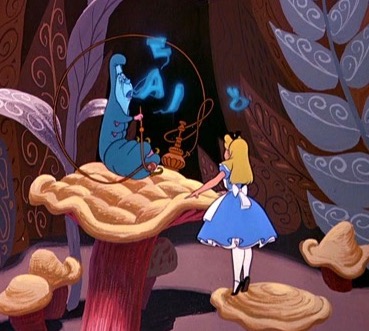One year ago, Consumer Corner was born to bring you consumer-derived insights drawn from non-traditional places to garner understanding for those in food and agricultural business. If you’ve hung around here long enough, you probably know I refer to my good friend Alice (yes, the Alice from Alice in Wonderland) quite a bit. When Consumer Corner first began, we took to Alice to learn about what problems are actually worth solving. On our half-birthday, we celebrated with inspiration from the Alice in Wonderland Unbirthday song, which posits the idea that every day but one each year is an unbirthday, with the point being that there’s always an excuse to celebrate.
Now, I know what you’re thinking, because I’m thinking it too. It would simply be unjust to celebrate Consumer Corner’s first birthday without Alice, who has now become our good friend. She’s seen us through a lot over the past 12 months, and she’s not done providing us inspiration yet…
Personally, I would not suggest eating any side of a random mushroom that you find, no matter how inviting the path you’re on when you find it. Not even if a talking caterpillar were to explain to you that eating one side of the mushroom will make you grow larger, while the other side of the mushroom will make you grow smaller. Although it wasn’t made an issue of in Lewis Carroll’s 1865 novel, Alice’s Adventures in Wonderland, or Disney’s 1951 animated Alice in Wonderland film, one may wish to question how a round mushroom has sides anyway.
It seems the decision making situation was dire for Alice from the start, given a round mushroom and explicit instructions about ‘sides’. Never mind the fact that these instructions are coming from a talking caterpillar, yet she’s about to eat a mushroom as an experiment to see which side will make her grow taller and which side will make her grow shorter anyway. But we all know how this story goes — she ate one side and outcome was poor. So, naturally, she ate the other side to balance it out and get herself ‘just right’. At this point, we’re obligated to question the decision making capacity of Alice, having drank the “Drink Me” blue drink, eaten the “Eat Me” cookies, and experimented with eating one ‘side’ of a mushroom to balance out the effects of having eaten the other side.
Sure, Alice sounds like a decision making nightmare, yet she simultaneously sounds all too familiar. Our own decision making processes are often fraught with questionable paths, meandering along more like Alice than perhaps most of us care to admit. Back in June 2020, I stated rather flippantly when introducing the decision making capacity of Alice: “Spoiler alert: consuming one mushroom in the forest with undesirable outcomes might cause one to pause before assuming the solution to one’s next challenge is a different mushroom.” Now, here we are in June 2021 and I still think this is true. At the very least, it’s cause for pause. Even better … Don’t eat the random mushroom in the first place, perhaps?
There are a variety of reasons why we struggle with decision making and, in particular, why we shout from the rooftops that we are making data-driven decisions but then pause or turn back when it doesn’t ‘feel right’ or we attempt decision making from data that simply isn’t sufficient. There are psychological decision traps, biases inherent in our thinking or interpretation of data, and the deeply instilled preference for ‘sticking it out’ and refusing to pull the plug. You might remember Operation Mall Bunny in which we reminded ourselves that refusal to change one’s mind in business is a learned skill, as children certainly do not suffer this challenge. Perhaps the most fundamental challenge, which seems simple but most certainly is not, is that in order to make the right choice, one must first know what they are attempting to do (or where they are attempting to go).
Alice’s Adventures in Wonderland, Chapter 6
“Would you tell me, please, which way I ought to go from here?”
“That depends a good deal on where you want to get to,” said the Cat.
“I don’t much care where–” said Alice.
“Then it doesn’t matter which way you go,” said the Cat.
“–so long as I get SOMEWHERE,” Alice added as an explanation.
“Oh, you’re sure to do that,” said the Cat, “if you only walk long enough.”
The unfortunate truth #1 about data-driven decision making is that data can’t assist you in making a decision towards an end that you have not yet defined. You have to know where you want to go or what you want to do before you can hope to make decisions that get you there.
Data-driven decision making or, at the least, data-informed decision making has been a recent focus of attention by executives in businesses and even us as individuals in everyday home life. Certainly an informed decision is superior to the alternative — an uninformed decision. Data-driven decisions sound good, and using actual data derived from the real world to make decisions about what to do in that same world simply makes sense. However, there are challenges with this approach that are underappreciated and nearly never mentioned. These challenges are numerous, but two key ones rise to the top, making them worth mentioning here: (1) you actually need data and analytics, and (2) you have to figure out how to actually give yourself the opportunity to do what the data tells you to do. Number 2 is especially hard because data-driven decision making doesn’t meant that you follow the data when you want to and you don’t when you don’t want to.
The unfortunate truth #2 is that you can no longer do whatever you want to do, what feels right or what your gut says to do; you may now have to do things you might not necessarily want to do, and that is really hard sometimes.
The House Advantage by Jeffrey Ma outlines a whole series of examples of unfortunate truth #2. There is a freely available keynote clip from one of Jeff Ma’s talks, and the 10 minutes you spend watching it may very well be the most valuable 10 minutes you’ve spent thinking about data-driven decision making yet. If you’re not familiar, Jeff Ma was the real-life inspiration for the movie 21, gaining worldwide recognition in the MIT Blackjack Club. He used math to beat the house and says, “Every decision you make at that blackjack table is 100% objective; there is no subjectivity, the numbers are all played out. Blackjack was big data before there was even such a thing.” The House Advantage is required reading in my Farm Management class where I pose the question: how is making a decision in blackjack, a game in which we have probabilities of various outcomes but no certainty, any different than making a decision on the farm where we also have probabilities of various outcomes but no certainty?
There are times that the math tells you to do something you don’t want to do. Maybe it’s making a big bet, and that’s simply scary. Maybe last time around you made the right decision but had a bad outcome, so this time around you’re feeling timid about making the right decision in the face of uncertainty.
The unfortunate truth #3 is that you cannot let the fear of a bad outcome stop you from making the right decision. It is entirely possible to make the right decision and experience a bad outcome, and it’s also possible to make the wrong decision and experience a good outcome. However, the outcome is not what we should be worried about in evaluating the decision. Instead, we need to separate the decision from the outcome.
From Jeff Ma: “I’m standing behind you, let’s say next year in Vegas, you have a 16 and the dealer has a 9 up. And you say to me, hey Jeff, what did you say I was supposed to do here. I say, hey, you’re supposed to hit. If you get a 5 to make 21 and win, I’m a genius, but if you get a 6 to get 22 and lose, I’m a moron that they never should have made a book or a movie about. But in both cases the decision was 100% correct; one was just a poor outcome and the other was a great outcome.”
Back in June of 2020 I authored a Consumer Corner letter entitled Why is a Raven Like a Writing Desk? The answer is that a raven is not like a writing desk and it doesn’t matter why, but hundreds of people have attempted to answer this riddle, because that is what we do — we try to find the answers to the questions we have.
The unfortunate truth #4 is that you have to be able to identify questions for which there are no answers, or, for which the answer simply doesn’t matter. If we’re going to invest time, effort and money into data-driven decision making, we need to prioritize which decisions are deserving of our attention. Don’t chase unicorns, and don’t set out to answer questions for which the answer is irrelevant.
ConsumerCorner.2021.Article.06





